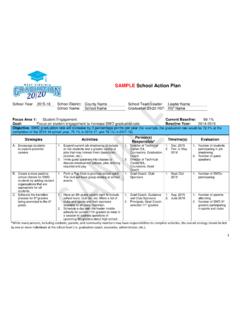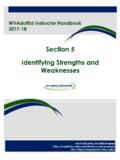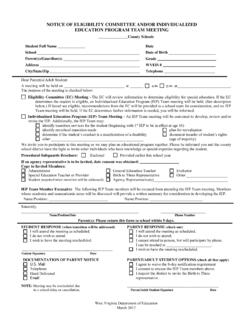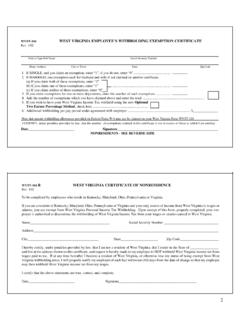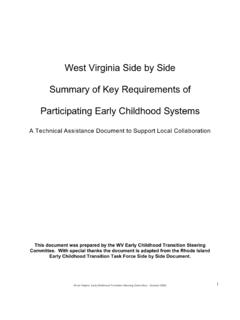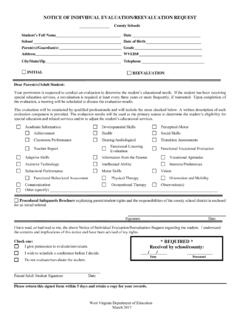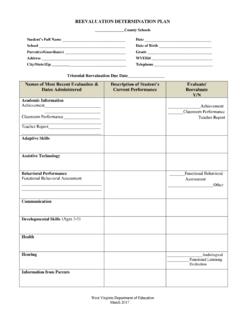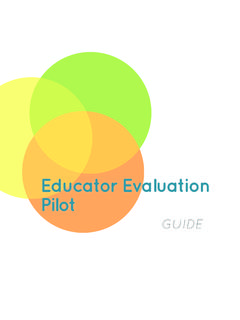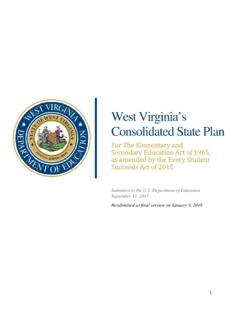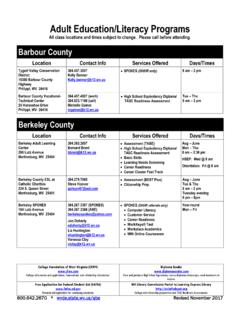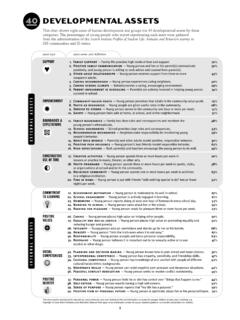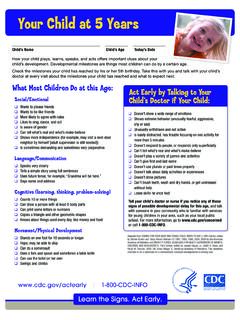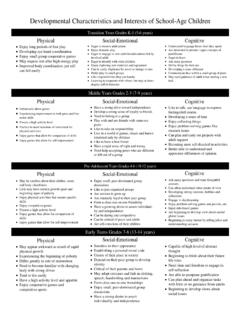Transcription of The Creative Curriculum Developmental Continuum
1 Expanded Forerunners The Creative Curriculum Developmental Continuum For Ages 3-5 Copyright 2005 Teaching Strategies, Inc. All rights reserved. No part of this book may be reproduced in any form or by any means without the prior written permission of Teaching Strategies, by: Teaching Strategies, box 42243 Washington, dC in the united StatesISbN 13: 978-1-933021-13-3 ISbN 10: 1-933021-13-6 The Expanded Forerunners of The Creative Curriculum Developmental Cont nuum for Ages 3 5 Thanks to Whit Hayslip and Karen Krische for their leading role in the development of the Expanded Forerunners of The Creative Curriculum Developmental Continuum for Ages 3 5. The following individuals participated in developing the Forerunner steps and examples and in the process of reworking many drafts: Sheryl Babbitt, Karen Britton, Mindy Brookshire, Jan Davis, Anne Kuschner, Nancy Lieberman, Michael Lopez-Breaux, Joyce Palacio, Eileen Shimony, Monica Vacca, Elizabeth Villase or, and Helene Weingarten.
2 The Expanded Forerunners team at Teaching Strategies included Diane Trister Dodge, Toni Bickart, Jennifer Park-Jadotte, Candy Jones, Jennifer Love King, and Laurie The Expanded Forerunners of The Creative Curriculum Developmental Cont nuum for Ages 3 5 The Expanded Forerunners of The Creative Curriculum Developmental Cont nuum for Ages 3 5 The Expanded Forerunners of The Creative Curriculum Developmental Continuum for Ages 3 5A Guide for Users .. 3 SOCIAL/EMOTIONAL DEVELOPMENTS ense of Self .. 9 Responsibility for Self and Others .. 10 Prosocial Behavior .. 12 PHYSICAL DEVELOPMENTG ross Motor .. 13 Fine Motor .. 14 COGNITIVE DEVELOPMENTL earning and Problem Solving .. 15 Logical Thinking.
3 17 Representation and Symbolic Thinking .. 19 LANGUAGE DEVELOPMENTL istening and Speaking .. 20 Reading and Writing .. 22 The Expanded Forerunners of The Creative Curriculum Developmental Cont nuum for Ages 3 53 The Expanded Forerunners of The Creative Curriculum Developmental Cont nuum for Ages 3 5 The Expanded Forerunners and this Guide supplement The Creative Curriculum Developmental Continuum for Ages 3 5 and A Teacher s Guide to Using The Creative Curriculum Developmental Continuum Assessment System. The primary purpose of the Developmental Continuum is to help teachers determine what individual children know and are able to do. With that information, teachers can plan a program that will help children continue to develop and learn.
4 Families, education officials, and the general public are also interested in children s progress. They want assurance that all children, including those with special education needs and diagnosed disabilities, have access to the general Curriculum , are working to attain the same high standards as their non-disabled peers, and are making progress. The Expanded Forerunners were developed with these concerns in mind and at the request of teachers who are working in both self-contained special education classrooms and inclusive the Forerunner LevelThe goals and objectives of The Creative Curriculum for Preschool give you direction for planning a developmentally appropriate program and a guide for determining how all children are progressing in four areas of development: social/emotional, physical, cognitive, and language.
5 The Creative Curriculum Developmental Continuum for Ages 3 5 outlines the typical development of preschool-age children by describing the steps that children usually take as they achieve each of 50 objectives. While Steps I, II, and III of the Developmental Continuum describe the stages of development for most preschool children, some of the children in your program might not have already reached Step do you describe the different strengths of children who have not yet reached Step I of a particular objective? How do you plan for their learning? How do you show their progress? The Expanded Forerunners of the Developmental Continuum describe three sequential Developmental steps (with examples) within the Forerunner level for each objective.
6 They help you observe children s emerging skills and understandings, describe their strengths and abilities, and assess their progress toward Step I. A Guide for Users The Expanded Forerunners of The Creative Curriculum Developmental Cont nuum for Ages 3 5 Children function at the Forerunner level for various reasons and for various lengths of time, and their abilities range widely. Some children at the Forerunner level simply lack experience or opportunities to develop particular skills or understandings. Others have a diagnosed disability in one area of development but function at a more advanced level in other areas. For example, a child who is physically challenged by cerebral palsy might be developing more quickly in terms of social/emotional, cognitive, and language objectives.
7 Still other children have delays across all four Developmental areas. A child who lacks experience may progress rapidly when provided opportunity, but a child with a disability, or one who is eligible for special education services for other reasons, may function throughout the preschool years at the Forerunner level in one or more Developmental areas. These children are still developing and learning, and the Expanded Forerunners offer a way to describe their strengths, plan appropriate support, and track their two children who are at the Forerunner level on Objective 17, Pedals and steers a tricycle (or other wheeled vehicle). Anna has cerebral palsy, which is a diagnosed disability; Zack lives in a high-rise apartment building and has never ridden a tricycle.
8 While neither child currently is able to pedal in a forward direction and to steer around wide corners (Step I), they have skills that are important to achieving that step. Anna is learning to balance on a tricycle while it is being pushed, which is Forerunner 1. Zack is learning to pedal and steer, which is Forerunner 3. Knowing where each child is functioning in relation to the Developmental Continuum and knowing the next step, their teacher is able to plan experiences and offer appropriate support to help each child progress. Because of her disability, Anna might remain at the Forerunner level on this objective throughout her preschool years, but she can be expected to move from Forerunner 1 to Forerunner 2 or 3.
9 Zack is functioning at a Forerunner level because of his lack of experience with tricycles. Given opportunities to ride tricycles regularly, he is expected to progress to Step I or further within a few Expanded Forerunners of The Creative Curriculum Developmental Cont nuum for Ages 3 5 Looking at the Objectives and the Expanded ForerunnersThe following illustration shows how the Expanded Forerunners describe sequential Developmental steps within the Forerunner level for each three shaded boxes below the long arrow are labeled Forerunner 1, Forerunner 2, and Forerunner 3. They describe points of emerging skill development before Step I of the particular objective. Step I approximates a beginning level of development typical of children ages 3 5.
10 For Objective 1, Shows ability to adjust to new situations, Forerunner 1 is Watches classroom activities with family member. An example of what a child might do at this Forerunner step is stand behind a family member to observe other next description of emergent behavior that relates to this objective is Forerunner 2: Engages in classroom activities when family member is nearby. For example, a child at the Forerunner 2 step might go to another part of the room with a teacher, checking back occasionally to see a family more advanced level of skill development is Forerunner 3: Engages in classroom activities with support of familiar staff member. An example that illustrates this Forerunner step is a child who joins an activity with a familiar teacher but looks toward the door through which his parent ObjectivesDevelopmental Continuum for Ages 3 5 Forerunner 1 Forerunner 2 Forerunner 3 Step I1.
